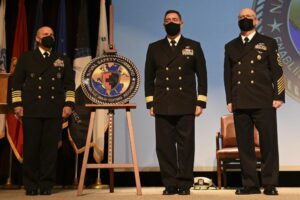The Navy’s second highest officer told a congressional committee last week the service wants the new Naval Safety Command to evaluate safety learning and performance as the service already does for ship readiness and condition.
Vice Chief of Naval Operations Adm. William Lescher said the newly converted Naval Safety Center will help inform how the service is executing safety oversight across the fleet, noting it will “include the same best practice as INSURV does – an assessment of the unit’s ability to self-assess, which is fundamental to this get real-get better orientation that will scale the learning.”
INSURV is the Navy’s Board of Inspection and Survey, which evaluates the condition and readiness of ships, including testing new vessels before they are delivered to the Navy.
Whereas “INSURV evaluates a unit and a unit commander’s ability to self assess material condition, Safety Command will assess that for safety performance,” Lescher told a hearing held jointly by the House Armed Services Seapower and Projection Forces and Readiness subcommittees on March 3.
The Navy formally elevated the former Naval Safety Center into Naval Safety Command last month, led by a two-star admiral. The service said it will serve as the naval enterprise lead for non-nuclear safety standards, expertise and oversight of the Navy and Marine Corps Safety Management System. The command is led by Rear Adm. F.R. Luchtman, the commander of the previous iteration, which he assumed in April 2020 (Defense Daily, Feb. 4).

In January, Chief of Naval Operations Adm. Mike Gilday said this change aims to help the fleet focus on learning and supporting sailors by evaluating how effectively it commands self-assess performance (Defense Daily, Jan. 13).
Elevating the safety center to a command was the first recommendation of the Major Fires Review from the investigation of the Bonhomme Richard fire. It argued the stronger organization would strengthen safety oversight and enforcement.
Lescher said the safety center never looked down at the fleet, type commanders (TYCOMs) or the immediate superior-in-command (ISIC), but “always looked at the [echelon-5] unit as an assist visit.”
In contrast, “the Naval Safety Command is a reorientation, fundamentally, of the Naval Safety Center to a down echelon.”
The new command will “audit the fleet, the TYCOM, the ISIC…how are you executing your safety oversight. Audit that, feedback, transfer best practices, at the ech-5 level, at the unit,” Lescher said.
He added what is new is there will be an evaluation that goes up an echelon, “to take our blinders off about what we’re seeing broadly across the fleet, and then we’ll include in the same best practice as INSURV does: an assessment of the unit’s ability to self-assess, which is fundamental to this get real-get better orientation that will scale the learning.”
Lescher said the safety command results will be passed up to the fleet level and will check previous Navy learning and recommendations directed by the Learning to Action Board.
The Learning to Action Board seeks to help the Navy see if the Major Fire Reviews’ recommendations are being implemented and what impact they are having.
“The Learning to Action Board is not aspirational. It’s met three times already and…it’s providing the structure that’s closing the feedback loop that I think was absent before,” Lescher said.
He compared it to the Readiness Reform Oversight Council that implemented 117 recommendations from reviews of the 2017 Fitzgerald and McCain destroyer collisions but as more enduring. The new Board implements and verifies implementation and also tests implementation to see if the fixes are in place and making a difference.
Lescher said some of the background to the Learning to Action Board was that in 2012 the USS Miami (SSN-775) Los Angeles-class attack submarine had an arsonist start a fire that burned the vessel to an irreparable state. The Navy implemented fixes to reduce the possibility of that repeating, but in 2020 the USS Bonhomme Richard (LHD-6) Wasp-class amphibious assault ship had a fire allegedly caused by an arsonist that burned it to an irreparable state.
“Where’s the learning there? And so what we’ve learned, as part of the very strong conversation we had in November, was that the instruction, those policies were not coming alive in the private shipyards and were not coming alive with the triad of the USS Bonhomme Richard.” Lescher said.
“So, we were at unacknowledged risk, unseen risk in terms of self-talk that we put a fix in place but it was not widely being in the private shipyards effectively. So Learning to Action Board is a specific countermeasure to that effect.”
Lescher said the Board is “laser-focused” on quickly implementing recommendations from the Bonhomme Richard fire and at the most recent meeting decided to look at the implementation of the Fitzgerald and McCain recommendations.
“Are those still in effect, are they delivering the intended effect?”